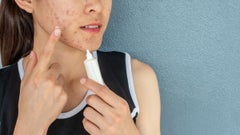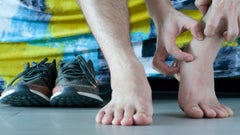
ketoconazole
Ketoconazole cream can help treat several different types of fungal skin infections. It's applied onto the skin and has very few side effects. This medication is only FDA approved for use in adults, since it isn't known if it's safe or works well in children.

What is Ketoconazole cream?
What is Ketoconazole cream used for?
Ringworm
Jock itch
Athlete's foot
Tinea versicolor (a fungal infection that causes discolored patches on the skin)
Skin yeast infection caused by Candida
How Ketoconazole cream works
Ketoconazole cream is an antifungal medication. It kills the fungus causing skin infections by damaging its protective outer layer.
Drug Facts

Get your GoodRx coupon

What are the side effects of Ketoconazole cream?
Common Side Effects
- Itching (5%)
- Skin irritation (5%)
- Stinging (5%)
Other Side Effects
- Rash at application site
Serious Side Effects
- Severe allergic reaction: hives, swelling, trouble breathing
Source: DailyMed
The following side effects have also been reported
Along with its needed effects, a medicine may cause some unwanted effects. Although not all of these side effects may occur, if they do occur they may need medical attention.
Check with your doctor immediately if any of the following side effects occur:
Less common—For cream, shampoo, foam, or gel
Itching, stinging, burning, or irritation not present before use of this medicine
Rare—For cream, foam, or gel
bleeding from sore in the mouth
blistering, crusting, irritation, itching, or reddening of the skin
burning, crawling, itching, numbness, prickling, "pins and needles", or tingling feelings
cracked, dry, or scaly skin
discoloration of the fingernails or toenails
dizziness
eye dryness, irritation, or swelling
red rash with watery, yellow-colored, or pus filled blisters with or without thick yellow to honey-colored crusts
skin dryness, pain, rash, redness, or swelling
sore in the mouth or on the gums
swelling of the face
Rare—For shampoo
Hair loss and irritation
Incidence not known—For gel
Incidence not known—For shampoo
Blistering, burning, crusting, dryness, or flaking of the skin
burning sensation of the skin
burning, itching, redness, skin rash, swelling, or soreness at the application site
discoloration of the hair
fast heartbeat
hoarseness
irritation
itching, scaling, severe redness, or soreness of the skin
joint pain, stiffness, or swelling
rash
shortness of breath
swelling of the eyelids, face, lips, hands, or feet
thinning of the hair
tightness in the chest
troubled breathing or swallowing
Some side effects may occur that usually do not need medical attention. These side effects may go away during treatment as your body adjusts to the medicine. Also, your health care professional may be able to tell you about ways to prevent or reduce some of these side effects. Check with your health care professional if any of the following side effects continue or are bothersome or if you have any questions about them:
Less common—For shampoo or gel
Dryness or oiliness of the hair and scalp
headache
Rare—For shampoo
Abnormal hair texture
mild dryness of the skin
scalp pustules
Other side effects not listed may also occur in some patients. If you notice any other effects, check with your healthcare professional.
Call your doctor for medical advice about side effects. You may report side effects to the FDA at 1-800-FDA-1088.

Pros and cons of Ketoconazole cream

Pros
Works well to treat many fungal skin infections
Skin usually starts improving shortly after starting treatment
Has few side effects
Applied directly to the affected area(s)
Available as a lower-cost generic

Cons
Must use for 2 to 6 weeks, depending on the type of infection
Not available over the counter
Not approved for use in children
Unknown if safe for pregnant or breastfeeding females
Some products are made with sulfites, which can cause allergies in some people.

Pharmacist tips for Ketoconazole cream

Most people using ketoconazole cream will notice results within a few days of starting it. Make sure to continue to use the medication the entire time your healthcare provider instructed you to do so. Stopping it too early can cause your infection to come back.
Use ketoconazole cream only on the skin. Don't put it in your eyes or anywhere else on your body to avoid side effects.
Wash and dry the affected areas of your skin well before applying ketoconazole cream. Some stinging or itching after using the medication is possible. But if you notice a rash appear, contact your healthcare provider.
Wash your hands well after using ketoconazole cream. This prevents the medication from getting in your eyes or other places on your body where you don't need it.
Even though ketoconazole cream treats tinea versicolor within a few weeks, your skin color might not return to normal for weeks or months after finishing your course of treatment. This doesn't mean ketoconazole cream didn't work. Ask your healthcare provider if you have concerns about your skin color after treatment.
If you're still having symptoms of your infection after you've finished using ketoconazole cream, let your healthcare provider know. You might need a different medication to treat your infection.

Frequently asked questions about Ketoconazole cream

How to save using GoodRx




What are the risks and warnings for Ketoconazole cream?
Ketoconazole cream can cause some serious health issues. This risk may be even higher for certain groups. If this worries you, talk to your doctor or pharmacist about other options.

Allergic reactions
Risk factors: Asthma | Allergy to sulfites
Some ketoconazole cream products contain sulfites. Although rare, this ingredient can cause a serious allergic reaction. If you're allergic to sulfites or have asthma, your risk of a reaction is higher. Sulfite and sulfa are not the same thing, and many people with sulfa allergies can still use medications containing sulfites. If you know you have a sulfite allergy, let your healthcare provider know before you start using ketoconazole cream. If you notice hives, swelling of the lips or tongue, or difficulty breathing after using ketoconazole cream, get medical attention right away.

Ketoconazole cream dosage forms
Typical dosing for Ketoconazole cream
Ringworm, jock itch, tinea versicolor, and skin yeast infections: Apply to the affected areas and the areas surrounding the infection once daily for 2 weeks.
Athlete's foot: Apply to the affected areas and the areas surrounding the infection once daily for 6 weeks.
Seborrheic dermatitis: Apply to the affected areas twice daily for 4 weeks or until the skin is clear.

Interactions between Ketoconazole cream and other drugs
Although certain medicines should not be used together at all, in other cases two different medicines may be used together even if an interaction might occur. In these cases, your doctor may want to change the dose, or other precautions may be necessary. Tell your healthcare professional if you are taking any other prescription or nonprescription (over-the-counter [OTC]) medicine.

How much does Ketoconazole cream cost?

What are alternatives to Ketoconazole cream?
Ringworm
Jock itch
Athlete's foot
Tinea versicolor (a fungal infection that causes discolored patches on the skin)
Skin yeast infection caused by Candida
Jock itch
Athlete's foot
Ringworm
Tinea versicolor (fungal infection that causes discolored spots on the skin)
Yeast infections of the skin
Seborrheic dermatitis of the scalp - shampoo and gel only
Fungal nail infection - nail lacquer only
Jock itch

What is the latest news about Ketoconazole cream?

Ketoconazole cream images
Get savings updates for Ketoconazole cream
Receive price alerts, news, and other messages from GoodRx about Ketoconazole cream and other healthcare topics and relevant savings offers.By signing up, I agree to GoodRx's Terms and Privacy Policy, and to receive marketing messages from GoodRx.
References
Best studies we foundAmerican Academy of Allergy, Asthma & Immunology. (n.d.). Sulfite and sulfa drugs.
Choi, F. D, et al. (2019). Topical ketoconazole: a systematic review of current dermatological applications and future developments. Journal of Dermatological Treatment.
Encube Ethicals Private Limited. (2021). Ketoconazole- ketoconazole cream, 2% cream [package insert]. DailyMed.
Tucker, D., et al. (2023). Seborrheic dermatitis. StatPearls.
Tasman Pharma Inc. (2022). Ketoconazole cream, 2% cream [package insert]. DailyMed.
U.S. Food and Drug Administration. (2017). FDA drug safety communication: FDA limits usage of nizoral (ketoconazole) oral tablets due to potentially fatal liver injury and risk of drug interactions and adrenal gland problems.
Compare other Seborrheic Dermatitis, Athlete's Foot, Ringworm, Jock Itch, Candidiasis, Fungal Infection, Thrush, Tinea Versicolor drugs
Browse medications
View AllResearch prescriptions and over-the-counter medications from A to Z, compare drug prices, and start saving.












